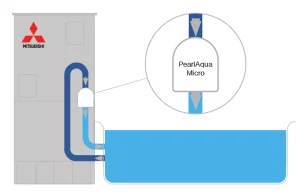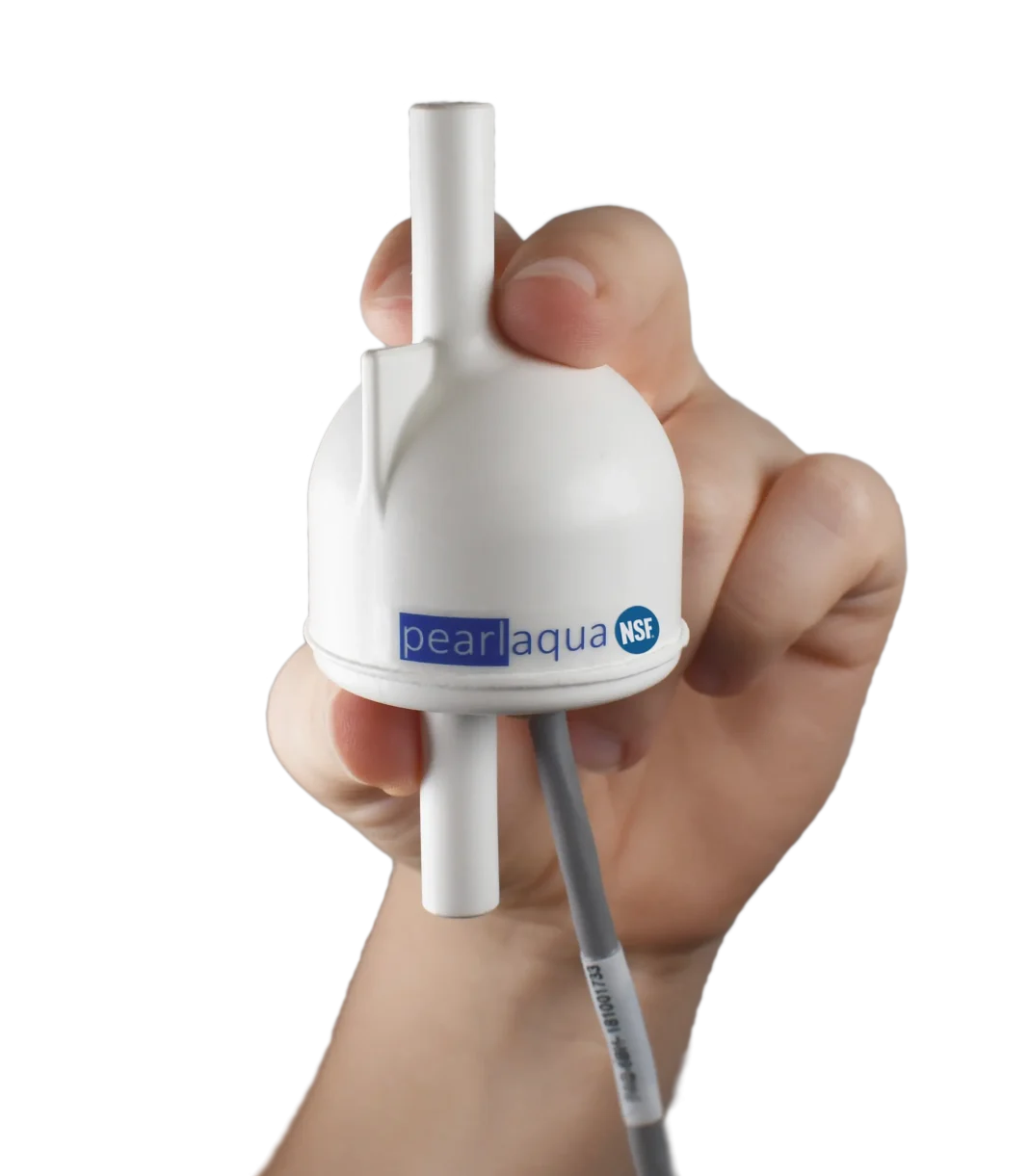Liz Stevens, writer, UV Solutions
AquiSense Technologies, Erlanger, Kentucky, recently earned the RadLaunch UV Engineering Project of the Year award for a project in which it partnered with global manufacturer Mitsubishi Electric Company. The project utilizes UV-C LED technology for disinfection of recirculating graywater within Mitsubishi’s EcoCute heat-pump hot water supply system. Currently used exclusively within the Japanese residential market, AquiSense engineered a unique solution based on its PearlAqua Micro™ product platform. AquiSense’s Mitch Hansen, marketing manager, and Molly McManus, project manager, talked with UV Solutions about key elements of the project.
Graywater Recycling, a Japanese Imperative
The graywater reuse market in Japan covers hundreds of thousands of units annually. With a high population density, most Japanese city dwellers live in apartments. Costs for water treatment, transport and heating are significant, so hot water is a precious resource. The island nation also places great value on its water quality, especially following the national impacts after decades of Minamata disease, a form of methylmercury food poisoning. The disease affected thousands of Japanese who consumed fish and shellfish containing methylmercury, which had been discharged into the water from a factory near Minamata, Japan, from the 1930s through the 1950s.1
In Japan, it is more economical to heat water during low energy-demand times, and it is customary for households to conserve water by reusing bath water. A hot-water supply system is installed in each household that manages water heating schedules and water recirculation. However, this increases the water contamination risk, allowing for potential bacterial growth. Mitsubishi’s recirculating heat-pump system, the EcoCute, historically included filtration but no disinfection technology to prevent the growth of bacteria. “The goal was to integrate UV-C technology for its strong bactericidal inactivation capabilities, while not compromising any of the existing EcoCute operating parameters, such as flow rate, temperature, environmental rating and service intervals,” Hansen explained. “Since this is an application for the domestic Japanese market, any system using mercury-based UV lamps is a big concern. Mitsubishi was adamant about using UV-C LEDs.”
Mitsubishi evaluated many UV-C LED and UV system suppliers before selecting AquiSense as the partner capable of delivering the required specification and able to quickly ramp up production to meet the rigorous quality requirements for high-volume supply. The two companies worked in close collaboration to design and test a custom variation of AquiSense’s golf-ball-sized PearlAqua Micro module as a component for Mitsubishi’s EcoCute.
Redesigning and Resizing
In approaching the project for this high-volume residential application, AquiSense capitalized on already having an existing product platform in the PearlAqua Micro that has been supplied in numerous configurations and applications globally since 2017. It is exclusively manufactured in Kentucky. AquiSense has invested in high-volume production tooling and advanced quality-control processes to ensure consistent product performance from using millions of LEDs. The assembled UV-C modules are roughly ¼ of the size of comparable low-pressure mercury vapor systems, which was a key draw for Mitsubishi’s selection criteria – a small, low-energy, low-flow but highly effective disinfection module that could be integrated into the existing Mitsubishi EcoCute product.
Advantages of LEDs
 The PearlAqua Micro’s diminutive size was not the only advantage in building a UV-C disinfection module with LEDs. Using LEDs, which in the AquiSense module can be powered by 12- or 24-volt direct current, allows for instantaneous full power and unlimited on/off cycling. “That is very different,” said McManus, “from a traditional mercury system, which has a warm-up time and which can only be turned off and on a limited number of times before the lamp starts to age prematurely.” She also noted that an LED system is an energy saver since it only draws power while it is treating water.
The PearlAqua Micro’s diminutive size was not the only advantage in building a UV-C disinfection module with LEDs. Using LEDs, which in the AquiSense module can be powered by 12- or 24-volt direct current, allows for instantaneous full power and unlimited on/off cycling. “That is very different,” said McManus, “from a traditional mercury system, which has a warm-up time and which can only be turned off and on a limited number of times before the lamp starts to age prematurely.” She also noted that an LED system is an energy saver since it only draws power while it is treating water.
When asked about the wavelength of UV-C used for the new module, Hansen and McManus stated that there is debate on what wavelength is best – a debate that may partially stem from the wide range of wavelengths possible with LEDs. “A traditional mercury lamp is going to generate at 253.7 nanometers,” said McManus, “often rounded to 254nm.” When it comes to LEDs, she continued, “some people advocate for 265nm, which rightly is the most effective wavelength for DNA absorbance. At AquiSense we select UV-C LED types by balancing a number of criteria, one of which is wavelength. We focus on wavelengths in the 260 to 280 nanometer range, but since a lower wavelength LED may have a lower lifetime or UV-C output, or even a higher cost, ultimately the choice has to be a balance of multiple parameters.”
Now and the Future
The fruits of the collaborative project are abundant. Currently, AquiSense provides Mitsubishi with around 100,000 UV-C LED modules per year. Beyond Mitsubishi, other corporations in the graywater reuse market are coming online in 2021, and AquiSense is set to double production in this application over the next 18 months.
Hansen explained how moving away from traditional UV systems and applications has allowed AquiSense to explore many new markets. “Traditional UV systems were geared toward a few established applications, mostly within municipal, industrial and residential markets,” he said. “In municipal applications, the flow is in millions of gallons a day; in a home, it is a few gallons a day. A lot of companies focus on how large they can make their UV systems; instead, we tried to see how small we could go.”
AquiSense’s micro module is so small, and LEDs can fit into such tight spaces, that many of the company’s application uses are where traditional UV could never have been used. For drinking water installations, a micro module can integrate into the faucet, water cooler spigot or water-bottle fill station.
Hansen also noted that LEDs are ideal for mobile, off-grid and portable applications. “They fit perfectly in off-grid cabins, mobile homes, RVs, boats or tiny homes,” he said. “They could work for emergency response. We are seeing more and more natural disasters; LED-based disinfection modules could provide clean water in disaster areas where the need for drinkable water is crucial.”
The recent hurricane disaster in Puerto Rico is an example, during which the US airlifted pallets of bottled water to the territory. “Imagine this: Instead of airlifting plastic single-use water bottles,” said Hansen, “how about just providing portable water treatment systems so that communities could treat the water that is already there? With one delivery, potable water can be made available for months vs. delivering bottles of water that fill the need for only a short time.” Further to the economy and sustainability of UV-C LED systems, McManus pointed out that LED systems can have a much longer service life with less frequent lamp change intervals.
McManus and Hansen said AquiSense will announce new developments during Q4 of 2021. “Keep an eye on us,” said McManus, “We are going to rock the industry with a larger-scale project installation only thought possible years from now.”
For more information on AquiSense and its UV-C LED disinfection offerings, visit www.aquisense.com or contact Hansen and McManus at info@aquisense.com.
References
1. T. Yorifuji, T. Tsuda, in Encyclopedia of Toxicology (Third Edition), 2014, accessed via Science Direct, https://www.sciencedirect.com/topics/nursing-and-health-professions/minamata-disease






